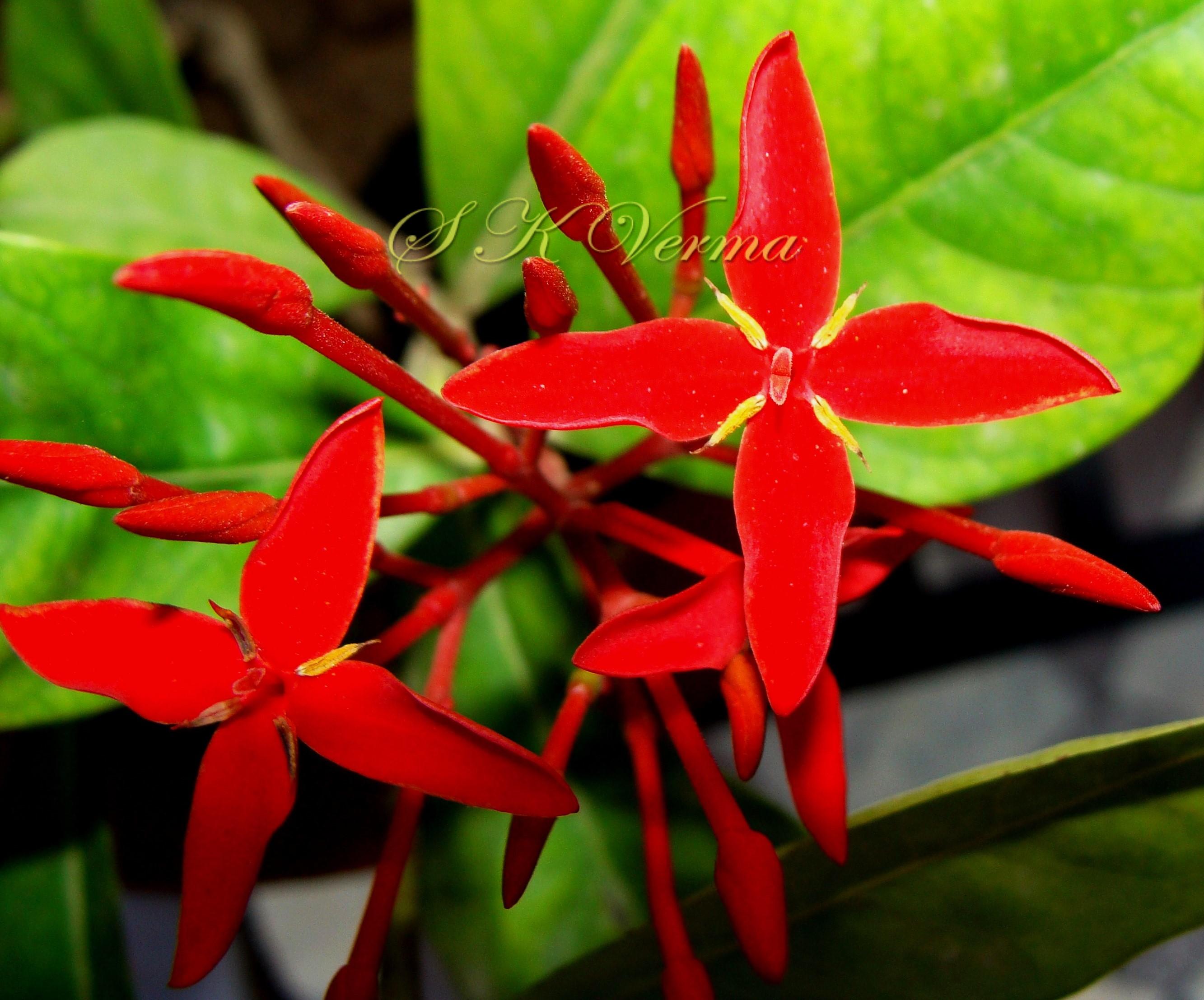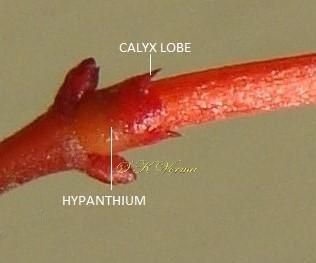IXORA
Ixora
L., Sp. Pl. 1: 110. 1753; Gen. Pl. ed. 5: 48. 1754; Benth & Hook. f., Gen. Pl. 2: 113. 1873; Hook. f., Fl. Brit. Ind. 3: 137. 1882; Cooke, Fl. Pres. Bomb. 2: 609. 1902; Parker, For. Fl. Punj. ed. 1:285. 1918 (Reprint 1973); ed. 2: 290. 1924; Bailey, Stand. Cycl. Hort. 1: 1710. 1950; Bor & Raizada, Beaut. Ind. Climb. Shr. and Trees. 85. 1954; Chen & Taylor, Fl. China @ eFloras.org 19: 177; Nazim. & Qaiser, Fl. Pak. @ eFloras.org p. 121.
Evergreen shrubs or small trees, unarmed. Leaves opposite, rarely 3-whorled; generally glabrous and coriaceous; petioles articulate at base; stipules interpetiolar, persistent or caducous. Inflorescence terminal on principle stems, sometimes on leafless lateral shoots or sometimes cauliflorous, cymose to corymbiform or paniculiform corymbose cymes, trichotomously branched; few to many flowered, sessile to pedunculate; bracteate or bracts reduced; axes often articulate; bracteoles when present fused in pairs. Flowers pedicellate or sessile, bisexual, actinomorphic, mostly 4-merous, occasionally 5-merous, generally white, red or pink, mostly fragrant. Calyx tube ovoid, lobes short, persistent. Corolla salver-shaped; tube long and slender, terete, always longer than lobes, throat naked or bearded; lobes 4, spreading, twisted in bud. Stamens 4, inserted on throat or mouth of corolla; filaments very short or absent; anthers dorsifixed near base. Disc thick or swollen. Ovary 2-locular, ovules solitary per cell (peltately attached to septum in each loculus); style filiform, branches 2, shortly exserted, diverging or recurved, rarely persistently connate. Fruit drupaceous, globose or didymous with persistent calyx, pyrenes 2, 1-celled each with one seed, coriaceous. Seeds peltate, testa membranous.
561 species
Ixora chinensis
Ixora chinensis
Lam., Encycl. 3: 344. 1789; Bailey, Stand. Cycl. Hort. 2: 1711. 1950; Bor & Raizada, Beaut. Ind. Climb. Shr. and Trees. 89. 1954; Nazim. & Qaiser, Fl. Pak. @ eFloras.org p. 127; Fl. China @ eFloras.org 19: 179.
Shrubs, 1-2 m tall; branches glabrous. Leaves opposite, rarely whorled, sessile or petiolate, petiole ca. 5 mm long; leaf blade 6-15 cm x 3-7 cm, oblong, elliptic, elliptic-obovate, base cuneate, truncate or rounded, apex obtuse to acute, margin entire, lateral nerves 9-12 pairs. Stipules interpetiolar, 3-7(-10) mm long, broad, triangular, awned, glabrous or glabrescent, persistent. Inflorescence terminal, congested-cymose to congested-corymbiform, many-flowered, sessile to pedunculate, peduncle 0-1.5 cm long, often subtended by 2 reduced leaves or leaflike bracts, branched portion 1-4 cm x 1-5 cm (excluding corolla), puberulent; bracts triangular, subulate, 0.2-1 mm. Flowers bisexual, actinomorphic, 4-merous, pink, scarlet or orange, central flowers sessile and two side flowers pedicellate, pedicels 2-3 mm long, red, each with a pair of small bracteoles. Calyx glabrate, red; hypanthium/ calyx tube obconic to ovoid, 1.5 mm long; limb deeply lobed, lobes 4, 0.5-1 mm, triangular, acute. Corolla red, +/- glabrate, tube +/- 2.5 cm long, minutely hairy at base outside; limb deeply lobed, lobes 4, 11-15 mm x 6 mm, ovate, elliptic or broadly elliptic, throat glabrous. Stamens 4, exserted, inserted on throat, alternating with corolla lobes; filaments very short, 1-1.5 mm long, red recurved; anthers ca. 3 mm long, acuminate, base sagittate, basifixed. Disc thick or swollen. Ovary inferior, 2-locular, 1 ovule per locule; style filiform, 1.5-2 mm long, exserted; stigma 2, linear, recurved.
Drupes reddish black, subglobose and shallowly didymous, 6-7 mm x 6-7 mm, glabrous. (Fruits not observed)
Common Names: Chinese Ixora
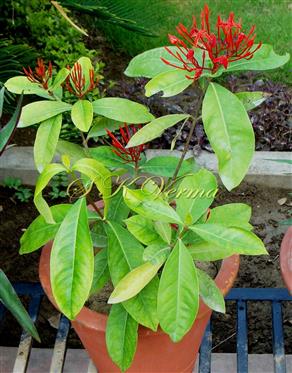
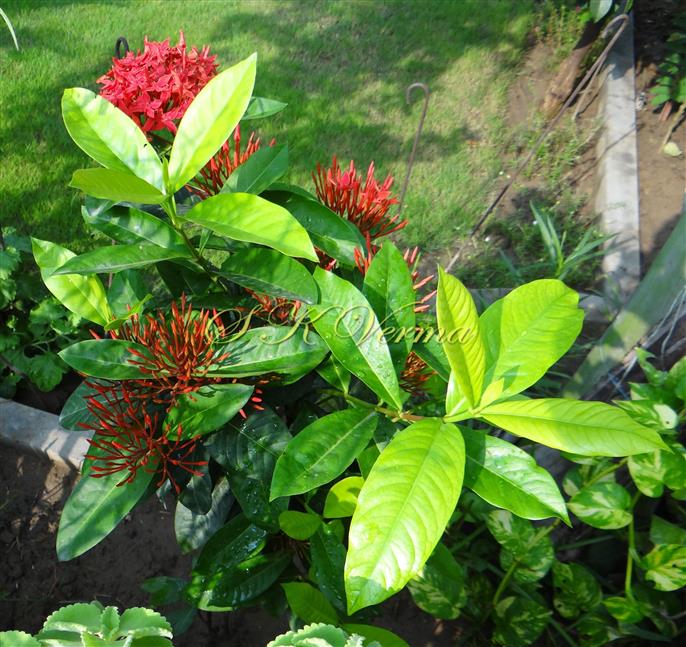
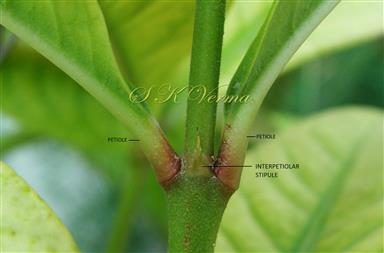

-DSC06715.jpg)

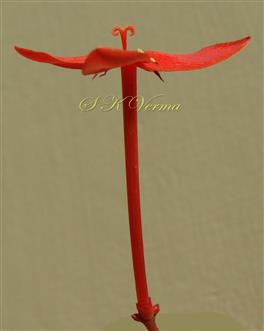


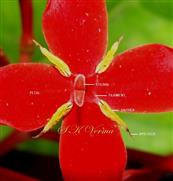





-DSC06715.jpg)
